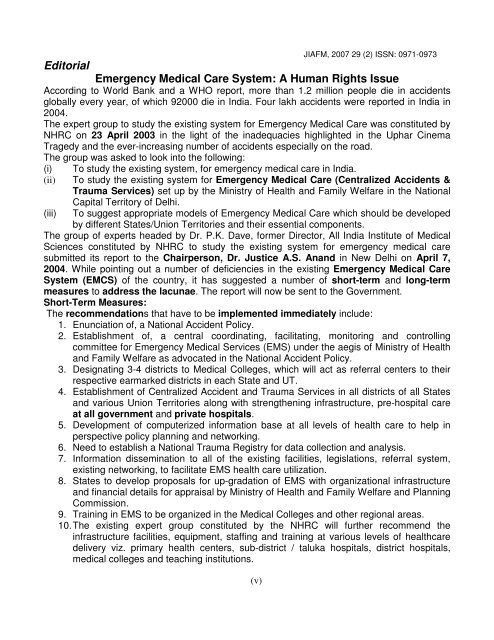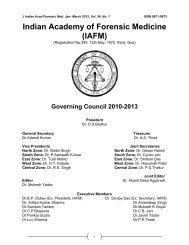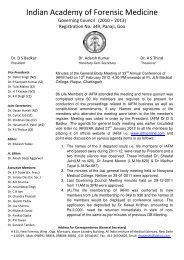Journal of Indian Academy of Forensic Medicine (JIAFM)
Journal of Indian Academy of Forensic Medicine (JIAFM)
Journal of Indian Academy of Forensic Medicine (JIAFM)
Create successful ePaper yourself
Turn your PDF publications into a flip-book with our unique Google optimized e-Paper software.
(v)<br />
<strong>JIAFM</strong>, 2007 29 (2) ISSN: 0971-0973<br />
Editorial<br />
Emergency Medical Care System: A Human Rights Issue<br />
According to World Bank and a WHO report, more than 1.2 million people die in accidents<br />
globally every year, <strong>of</strong> which 92000 die in India. Four lakh accidents were reported in India in<br />
2004.<br />
The expert group to study the existing system for Emergency Medical Care was constituted by<br />
NHRC on 23 April 2003 in the light <strong>of</strong> the inadequacies highlighted in the Uphar Cinema<br />
Tragedy and the ever-increasing number <strong>of</strong> accidents especially on the road.<br />
The group was asked to look into the following:<br />
(i) To study the existing system, for emergency medical care in India.<br />
(ii) To study the existing system for Emergency Medical Care (Centralized Accidents &<br />
Trauma Services) set up by the Ministry <strong>of</strong> Health and Family Welfare in the National<br />
Capital Territory <strong>of</strong> Delhi.<br />
(iii) To suggest appropriate models <strong>of</strong> Emergency Medical Care which should be developed<br />
by different States/Union Territories and their essential components.<br />
The group <strong>of</strong> experts headed by Dr. P.K. Dave, former Director, All India Institute <strong>of</strong> Medical<br />
Sciences constituted by NHRC to study the existing system for emergency medical care<br />
submitted its report to the Chairperson, Dr. Justice A.S. Anand in New Delhi on April 7,<br />
2004. While pointing out a number <strong>of</strong> deficiencies in the existing Emergency Medical Care<br />
System (EMCS) <strong>of</strong> the country, it has suggested a number <strong>of</strong> short-term and long-term<br />
measures to address the lacunae. The report will now be sent to the Government.<br />
Short-Term Measures:<br />
The recommendations that have to be implemented immediately include:<br />
1. Enunciation <strong>of</strong>, a National Accident Policy.<br />
2. Establishment <strong>of</strong>, a central coordinating, facilitating, monitoring and controlling<br />
committee for Emergency Medical Services (EMS) under the aegis <strong>of</strong> Ministry <strong>of</strong> Health<br />
and Family Welfare as advocated in the National Accident Policy.<br />
3. Designating 3-4 districts to Medical Colleges, which will act as referral centers to their<br />
respective earmarked districts in each State and UT.<br />
4. Establishment <strong>of</strong> Centralized Accident and Trauma Services in all districts <strong>of</strong> all States<br />
and various Union Territories along with strengthening infrastructure, pre-hospital care<br />
at all government and private hospitals.<br />
5. Development <strong>of</strong> computerized information base at all levels <strong>of</strong> health care to help in<br />
perspective policy planning and networking.<br />
6. Need to establish a National Trauma Registry for data collection and analysis.<br />
7. Information dissemination to all <strong>of</strong> the existing facilities, legislations, referral system,<br />
existing networking, to facilitate EMS health care utilization.<br />
8. States to develop proposals for up-gradation <strong>of</strong> EMS with organizational infrastructure<br />
and financial details for appraisal by Ministry <strong>of</strong> Health and Family Welfare and Planning<br />
Commission.<br />
9. Training in EMS to be organized in the Medical Colleges and other regional areas.<br />
10. The existing expert group constituted by the NHRC will further recommend the<br />
infrastructure facilities, equipment, staffing and training at various levels <strong>of</strong> healthcare<br />
delivery viz. primary health centers, sub-district / taluka hospitals, district hospitals,<br />
medical colleges and teaching institutions.









